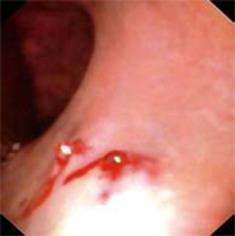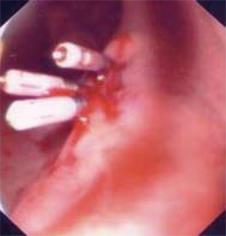INTRODUCTION
Screening for prostate cancer has become an important issue in recent years. Of all procedures used to diagnose prostate cancer, the gold standard is transrectal ultrasound (TRUS)-guided multiple biopsy of the prostate[12]. Complications from TRUS-guided prostate needle biopsy are occasionally encountered in the daily practice of urologists; the traditional spring-loaded device with a small-caliber needle used for the prostate biopsy is fast, safe, effective and associated with minimal complications, including self-limiting hematuria, hematospermia and pain[3–5]. Rare major complications include acute prostatitis, acute urinary retention, epididymitis, severe hematuria, sepsis, abscess formation, urinary tract infection, tumor tracking, vasovagal syncope, and significant rectal bleeding[3–7]. Most often, major and especially minor complications resolve with traditional conservative therapy[38]. Severe rectal bleeding is traditionally managed by the urologist, with rectum tamponade as the initial and simplest conservative method, or, when necessary, balloon compression by means of a transrectally inserted catheter[8]. Endoscopic intervention with injection of adrenaline and sclerosing solutions, thermocoagulation and band ligation have also been used successfully in some cases[9–13]. We describe, possibly for the first time, the use of endoclipping for the treatment of severe rectal bleeding following TRUS-guided prostate multiple biopsy.
CASE REPORT
A healthy 59-year-old internist was found to have prostate-specific antigen (PSA) at 5.8 ng/mL (normal < 3.5 ng/mL) during a screening test for prostate cancer. Laboratory data including platelet count, and prothrombin and bleeding times were normal. He underwent TRUS guided prostate multiple biopsy (18 cores) with a needle. Two hours later, he noticed rectal bleeding and thereafter he continued to pass a large volume of bright red blood through the rectum every 30 min. Manual compression and rectal tamponade with inflation of the balloon of an inserted urine catheter in the rectal cavity by his urologist failed to stop the bleeding. As a result of massive rectal bleeding that caused his hematocrit to drop from 45% to 28% and concomitant hemodynamic instability, he required hospitalization. Two packed red blood cell units were transfused and endoscopic consultation was requested. When transferred to our department, he was diaphoretic, with a pulse rate of 124 bpm and blood pressure of 100/70 mmHg. There was no history of hemorrhoidal disease. Urgent colonoscopy was performed without bowel preparation and revealed a rectal cavity full of fresh blood and clots, without a visible bleeding source. Vigorous washing and suction of the rectal cavity revealed two adjacent bleeding points in the anterior rectal wall, which corresponded to the sites of rectal wall injury caused by prostate multiple biopsy (Figure 1). Three endoclips (MH-858; Olympus, Tokyo, Japan) via an HX-6UR-1 applicator (Olympus) were applied to the bleeding lesions (Figure 2) and immediate hemostasis was achieved. The patient’s condition was stabilized and 2 d later, he was discharged with an uneventful recovery.
Figure 1 Endoscopic view showing oozing from biopsy sites in the anterior rectal wall.
Figure 2 Hemostasis achieved after application of three clips.
DISCUSSION
To the best of our knowledge, we report the first known severe rectal bleeding following TRUS-guided prostate biopsy, which was effectively managed by endoclipping.
There are two established techniques of prostate biopsy, including the more widely used transrectal technique, and the transperineal technique. Both techniques appear to be equally safe, although the transrectal technique is faster[14]. Currently, the preferred option for initial prostate biopsy is the transrectal procedure[15]. Nevertheless, concerns about the accuracy of the standard sextant prostate biopsy for detecting prostate cancer have led to more cores being taken in each patient. This is not surprising, as mathematical models have shown that sextant biopsy misses 27% of tumors, and the probability of identifying a fixed volume of prostate cancer increases by taking more cores[16]. Results from clinical studies have shown that the sextant protocol for TRUS-guided prostate biopsy can miss cancer in 19%-31% of cases[1718]. To overcome these diagnostic shortcomings, several extended biopsy policies have been advocated. Increasing the number of cores from six to eight, with extra cores targeted along the post-lateral margins of the gland, identifies up to 20% more tumors[19], but even an eight-core biopsy may miss cancer, and others have advocated[1618] more biopsies per gland[20–22]. However, trying to improve the diagnostic accuracy should not be at the expense of the increased complication rate that may accompany more core biopsies, particularly bleeding, as occurred in our patient, especially when the prostate and surrounding rectal tissue are supplied by a rich vascular bed that consists of branches of the inferior vesicular artery and the middle and inferior rectal arteries. Moreover, the venous plexus is also dense in the submucosal space of the region, particularly in patients with hemorrhoids. The total incidence of rectal bleeding is listed as 1.3%-58.6%, with a statistically significant positive correlation to the number of core samples obtained. In most cases, the rectal bleeding is slight without necessitating further therapeutic intervention[35].
To overcome further the aforementioned diagnostic shortcomings, evaluation of the accuracy of TRUS-guided biopsies, by using combined magnetic resonance imaging (MRI) and magnetic resonance spectroscopic imaging (MRSI) in patients with persistently high PSA levels and negative TRUS-guided biopsy results, has revealed that MRI/MRSI have the potential to guide biopsies to tumor foci in these patients[23]. Overall, MRI and MRSI have accuracy similar to biopsy for intraprostatic localization of tumor and they are more accurate than biopsy in the prostate apex. Therefore, these imaging modalities may supplement biopsy results by increasing physician confidence when evaluating intraprostatic tumor location, which may be essential for planning disease-targeted therapy[24]. Our patient did not accept further evaluation by these two imaging approaches.
In an extensive research of Medline using the key words rectal bleeding, prostate biopsy, hematochezia and rectal hemorrhage, we found seven publications that describe massive rectal bleeding occurring after transrectal biopsy, which required blood transfusion. In most of the cases, hemostasis was achieved with rectal tamponade by means of fleece tamponing, by urine balloon catheter inserted and inflated in the rectum by a condom filled with fluid in the rectal cavity, or after endoscopic intervention with injection of adrenaline or sclerosing solutions (polidocanol or pure ethanol), thermocoagulation and band ligation[9–1325]. In our case, neither rectal tamponade nor manual compression of bleeding sites by a urologist succeeded in achieving hemostasis. Since the patient presented with hemodynamic instability (diaphoresis, tachycardia with drop of blood pressure), endoscopic consultation was requested. Having significant experience of endoclips for treatment of upper and lower gastrointestinal bleeding[2627], we proceeded with urgent endoscopy combined with placement of three clips at the sites of bleeding, which led to immediate hemostasis. We preferred endoclips instead of sclerosing solutions, despite the fact that the latter have been successfully used to achieve hemostasis in post-biopsy prostate bleeding[2829], because we were concerned about their risk of subsequent formation of deep ulceration. In contrast, the use of endoclipping has been widely reported in gastrointestinal endoscopy, without complications[2627].
Argon plasma coagulation (APC) is a safe, well-tolerated treatment option in prostatic cancer patients with radiation-proctitis-induced hemorrhage, and historically, has been superior to Nd: YAG laser ablation[30]. Regarding the endoscopic treatment for initial hemostasis in upper and lower gastrointestinal bleeding, apart from the endoscopic hemostatic devices used, APC is an alternative hemostatic method[3132]. Its potential therapeutic application in patients with severe rectal bleeding following TRUS-guided prostate biopsy remains to be elucidated.
In conclusion, our case emphasizes that urgent endoscopy allows accurate diagnosis and endoclipping is a safe and effective therapy of massive rectal bleeding followed prostate biopsy.










